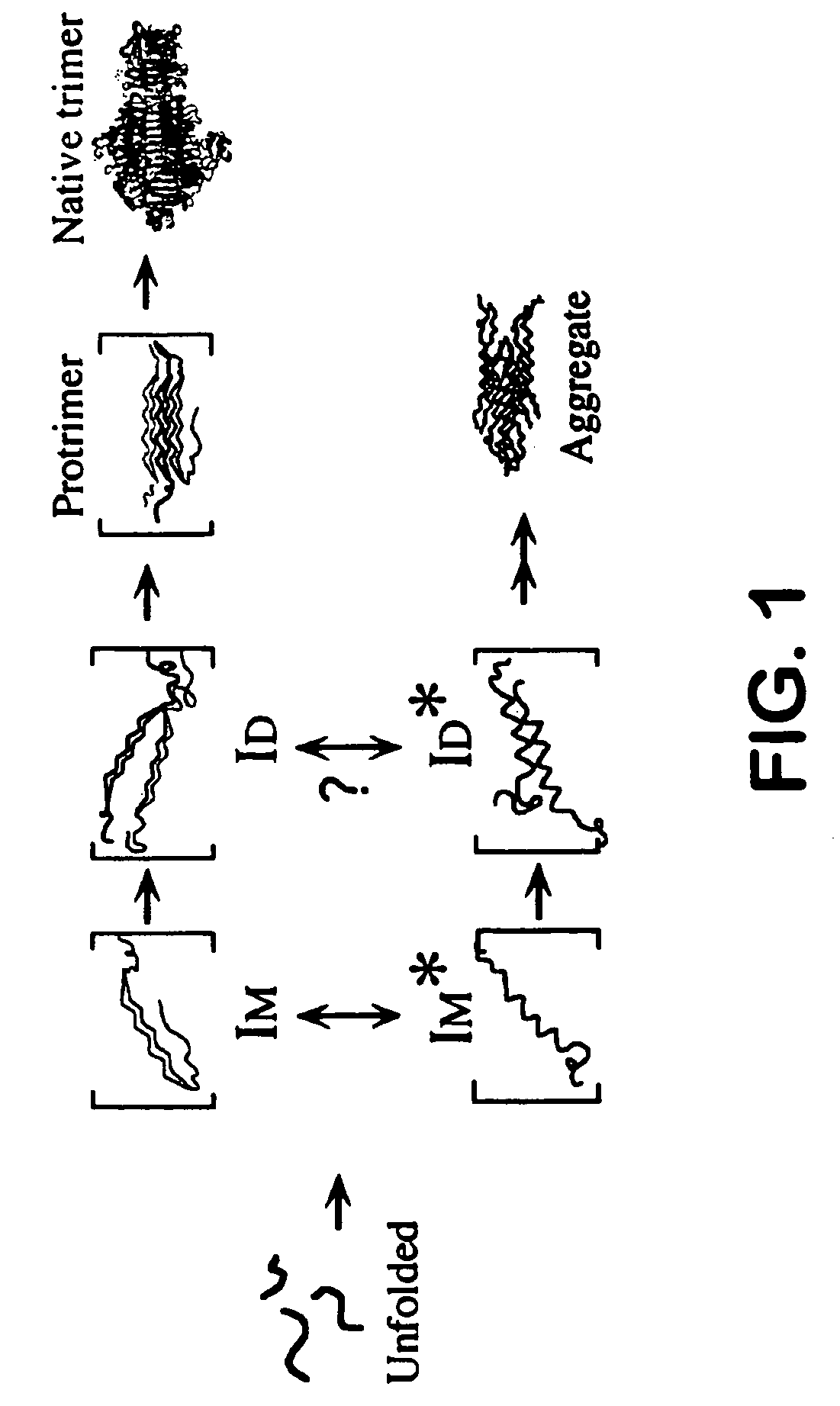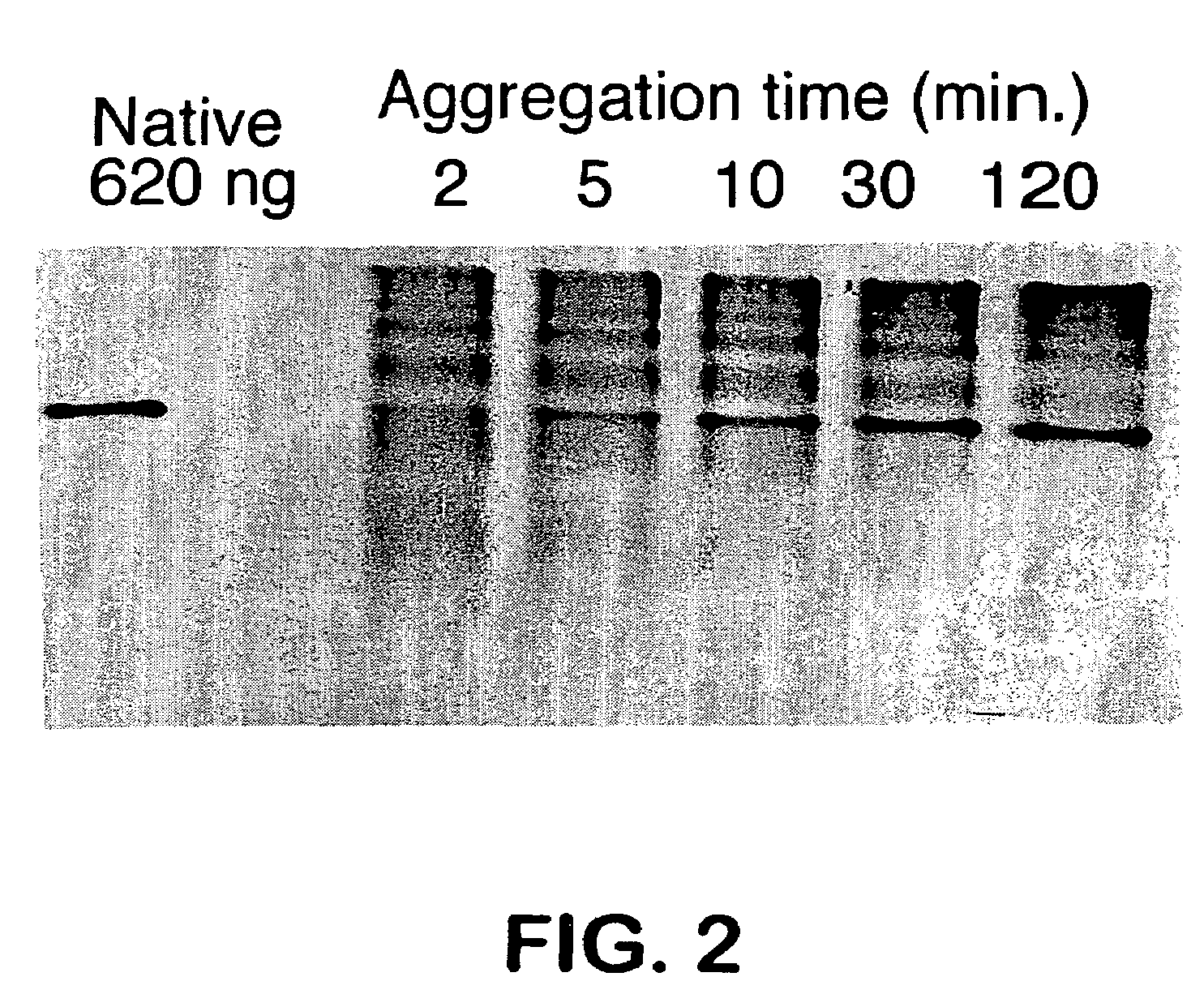Use of hydrostatic pressure to inhibit and reverse protein aggregation and facilitate protein refolding
a technology of hydrostatic pressure and protein aggregation, which is applied in the direction of peptides, immunoglobulins, organic chemistry, etc., can solve the problems of often severely limited production of recombinant proteins for industrial, research and medical applications, and achieve the effect of increasing the yield of native proteins and high protein concentrations
- Summary
- Abstract
- Description
- Claims
- Application Information
AI Technical Summary
Benefits of technology
Problems solved by technology
Method used
Image
Examples
example 1
Aggregation Reactions Can Be Monitored by HPLC
[0060]Tailspike Protein Production: Tailspike protein is produced by infecting Salmonella typhimurium strain 7136 with phage P22 (Winston et al., J. Bacteriol. 137:433-439 (1979). Purification and 14C metabolic labeling for radioactive protein is performed essentially as described in Robinson and King, Nature Struct. Biol. 4:450-455 (1997). Tailspike appears as a single band on both Coomasie- and silver-stained SDS gels. The tailspike protein is stored as an ammonium sulfate precipitate at 4° C., then dialyzed against 50 mM Tris-HCl (pH 7.0) and 1 mM EDTA just prior to use.
[0061]In Vitro Aggregation Reactions: Native tailspike protein is denatured for approximately 60 min in 7 M urea, 50 mM Tris-HCl (pH 3). The aggregation reaction is initiated by rapid dilution (12.5-fold) with 50 mM Tris-HCl (1 mM EDTA) at pH 7.6 to a final protein concentration of 100 μg / mL protein at 20° C. and 0.6 M urea. At 100 μ / mnL, greater than 90% of the tailsp...
example 2
Hydrostatic Pressure Inhibits and Reverses Tailspike Aggregation
[0070]To test the effect of hydrostatic pressure upon aggregation, samples of native tailspike are denatured, then transferred to refolding buffer under conditions which favor aggregation (t=26° C., [Pt]=1.4 μM chains) and allowed to aggregate for 30 minutes. These samples are termed “ambient aggregated tailspike.” An identical set of samples are denatured, transferred to refolding buffer under aggregation conditions, then subjected to 2.4 kbar 90 min, after 3.25 hours of aggregation at atmospheric conditions. These samples are termed “pressure-treated tailspike.” For each sample, the extent of refolding and aggregation is analyzed by HPLC (FIG. 4).
[0071]Treatment with 2.4-kbar hydrostatic pressure markedly increases the yield of native trimer, while substantially decreasing the extent of aggregation. FIG. 5 shows the distribution of tailspike monomers, trimers, and aggregates for pressure-treated tailspike samples and ...
example 3
Tailspike Trimers from Pressure Treatment Have Native-Like Structure
[0072]Fluorescence Spectroscopy: Fluorescence spectra are recorded using an Hitachi F4500 Spectrofluorometer. All measurements are made at 25° C., in a buffer containing 50 mM sodium phosphate (pH 7.0) and 1 mM EDTA. For all tailspike samples (native, ambient aggregated, and pressure-treated aggregates) the protein concentration is 4 μg / mL. The excitation wavelength is 280 nm, and emission spectra are recorded from 300 to 400 nm. Relative differences in the spectra are determined by determining total peak area as well as the center of mass (average energy of emission).
[0073]Results: To demonstrate that tailspike trimers formed from pressure-treated tailspike aggregate recover native-like structural and functional properties, the intrinsic fluorescence spectra and SDS-resistance of native, pressure-treated, and ambient aggregated tailspike are examined.
[0074]Tailspike aggregation is accompanied by a large decrease in...
PUM
| Property | Measurement | Unit |
|---|---|---|
| hydrostatic pressure | aaaaa | aaaaa |
| temperatures | aaaaa | aaaaa |
| temperatures | aaaaa | aaaaa |
Abstract
Description
Claims
Application Information
 Login to View More
Login to View More - R&D
- Intellectual Property
- Life Sciences
- Materials
- Tech Scout
- Unparalleled Data Quality
- Higher Quality Content
- 60% Fewer Hallucinations
Browse by: Latest US Patents, China's latest patents, Technical Efficacy Thesaurus, Application Domain, Technology Topic, Popular Technical Reports.
© 2025 PatSnap. All rights reserved.Legal|Privacy policy|Modern Slavery Act Transparency Statement|Sitemap|About US| Contact US: help@patsnap.com



